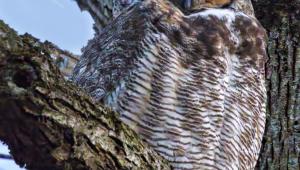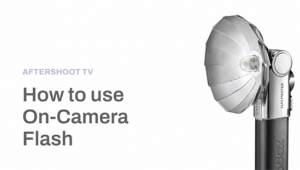The LGE FLATRON L2000C LCD Display & Apple Mac mini Intel Core Duo Computer; My Excellent Adventure In Photo Computing
After covering many of the new brand name LCD displays in previous Shutterbug reports, I could not ignore LG Electronics' (LGE) LCD displays, in part because they are likely the world's current leader in LCD manufacture, although most of the production is OEM and sold under many different brand names. Recently, however, LGE has been marketing under their own brand name and offering a diverse selection of LCD displays, including one that is modestly priced and recommended for pro graphics, the FLATRON L2000C 20.1" model.
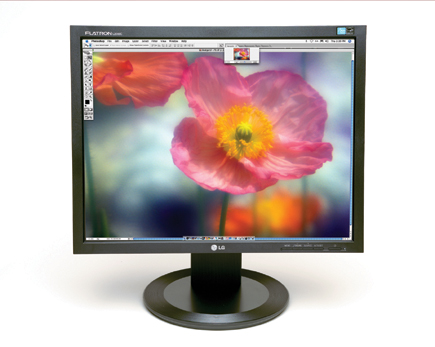 |
|
|
About the same time I decided to test the LGE L2000C LCD display, Apple announced
a new version of their budget-priced Mac mini computer with Intel Core Duo processor.
I was intrigued by the idea that photographers could access the superior digital
photography performance of an Apple Mac at a budget price ($599), and I was
due to replace an old Apple Mac G4 and its equally well-worn 21" CRT.
So I thought it was time to practice what I preach and purchased both the Mac
mini Intel computer and the LGE L2000C LCD display. My aim was to explore how
this modestly-priced computer system would work for digital photographers.
To start out the adventure I got onto my web browser to check costs for the
L2000C on PriceGrabber.com. I found a whole page of Internet sellers offering
the display with of course one low-ball price from a seller I'd never
heard of. Then, because I buy a lot of books and DVDs from Amazon.com, I checked
and found the LGE display offered at a price of $588 and change, a good buy
from a reliable vendor. So, I ordered the LGE L2000C. I did not bother to price
shop for the Apple Mac mini Intel because past experience has taught me there
is not much to be saved in cost from shopping around and that the Apple Store
offers superb service and reliable delivery. Between the two new Mac mini models
I chose the Solo processor base model with a price of $599, but then added RAM
to the system's full capacity of 2GB, and added a new keyboard and mouse
for another $78. So the total for both display and complete computer to meet
my requirements was about $1200 delivered, about half of what I paid last year
for my Apple Mac G5 dual-processor tower without a monitor!
The LGE L2000C Display
This very high-performance 20.1" LCD display is in the standard 3:4 aspect
ratio with a thin bezel. It is mounted on a stand that provides height, tilt,
swivel, and rotation adjustments so it may be used in either landscape or portrait
configuration. The actual physical size of the display screen image is 16x12",
which is the same as the Sony 21" (diagonal) CRTs I had been using for
some time. The 1600x1200 native resolution, wide viewing angle, and fast 8ms
response, with a maximum brightness of 300 cd/m2 and 800:1 contrast, provides
support for a wide range of uses in different environments. A full complement
of on-board adjustments, including brightness, contrast, gamma, color temperature,
and RGB balance, enable fine-tuned adjustments for a color managed environment,
all perfectly suited to digital photography image adjustment and editing. The
FLATRON L2000C also benefits from LGE's f-ENGINE, its proprietary picture-enhancing
chip, providing enhanced and user-definable brightness and color.
For a full list of Technical Specifications on this LCD display, visit the Instant
Links section of our website at: www.shutterbug.com/currentissuelinks/.
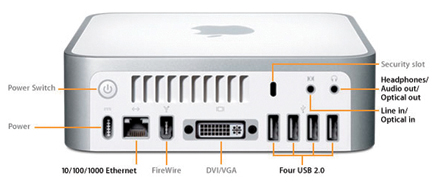 |
|
|
The Apple Mac mini (Intel Core Processor)
The Apple Mac mini is up against two prejudices: one is that Apple Macs are
expensive and the idea that bigger is better. The latter should be irrelevant
to anyone who has ever opened the case of a typical PC to add a card or peripheral
device. Most of what is inside the volume of space of a PC CPU box is empty
air. The Apple Mac mini is simply no larger than necessary to contain the essential
components and, at $599 for the entry price, is not expensive. So the remaining
question is: Will it provide the performance required by a digital photographer?
Before I answer that let me provide a brief description of what the newest Mac
mini Intel computers contain. The main mini computer enclosure has all of the
same functional components of any CPU box that supports contemporary computing.
That includes one of two versions of the Intel Core processors, either the Solo
or Duo, a hard drive with a range of choices in storage capacity up to 120GB,
one of two disc drives, depending on whether you require just CD-R or also DVD-R
recording capability, as well as a FireWire connector, four USB 2.0 connectors,
a DVI (with analog adapter) video connector, Ethernet support and connector,
and built-in support for Bluetooth and Apple's AirPort wireless networking.
The Mac mini even comes with a TV-like remote controller. The Power supply is
a smaller separate module, so the Mac mini is exceptionally quiet.
A monitor/display is a separate purchase, which gives digital photographers
a choice of displays that specifically support graphics and photography without
a penalty. Even the keyboard and mouse are optional, just in case you have them
already. And of course the most important aspect of this setup to a digital
photographer is the easy to use but high-end graphic support of the Apple Operating
System (OS) in the latest 10.4.6 version, pre-installed with every Mac. This
software also includes Apple's iLife with iPhoto, iTunes, iMovie, iDVD,
iWeb, and GarageBand, as well as MS Office 4 Mac and Quicken trial, and much
more.
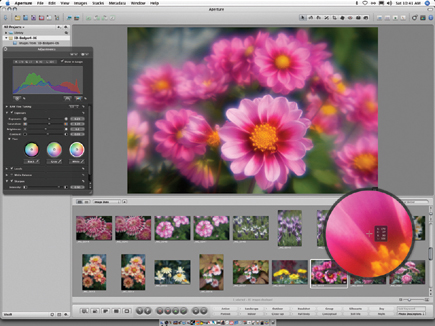 |
|
|
September 2006: Apple announced the Mac mini processors
would be upgraded so the entry model formerly with an Intel Core Solo will now
have the 1.66Hz Intel Core Duo, and the previous 1.66Hz model would now get
a 1.83Hz Intel Core Duo processor. This makes the Apple Mac mini even more inviting
as an inexpensive basis for a digital darkroom for photo enthusiasts.
For a full list of Technical Specifications on the Apple Mac mini, visit the
Instant Links section of our website at: www.shutterbug.com/currentissuelinks/.
Using The New Setup
The next week I was setting up a completely new system chosen just on the published
information. I've put more systems together since 1989 than I can remember,
but this time I really didn't know what to expect, so curiosity heightened
the sense of adventure. It took just a few minutes to go from boxes on the floor
to setting up the components and connecting them. I turned the power button
on for the LCD and then pressed the on button on the Mac mini, and in a few
seconds the LGE screen filled with Apple's welcome screens, inviting me
to answer some basic questions to set up the Apple OS. Shortly I got to a question
asking if I had another computer I wanted to transfer information and files
from to this new Mac. As I mentioned, I planned to use the new system to replace
an old G4 PowerPC Mac. To get it running I connected the new mini to it via
a FireWire cable. Then after a few more mouse clicks the new mini began transferring
the contents of the old G4's hard drive to my new system, including all
of my applications like Photoshop and SilverFast as well as all of the data
files, including images.
After a long coffee break the transfer was done, and I soon found just about
every application and file was perfectly intact and all the applications worked
fine. Just one thing was not transferred perfectly--my Internet setup settings.
But this was corrected in just another few minutes and I was online with Apple
to register my new Mac.
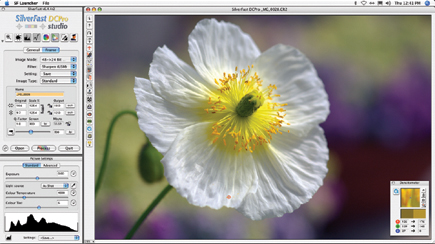 |
|
|
Profiling The LGE
To get started doing some real digital darkroom work, the next task was to adjust,
calibrate, and profile the LGE L2000C LCD display. I launched Photoshop and
opened my custom composite printer test file. Brilliant, but at the LCD's
default, as expected, it was too bright, washing out some of the highlight detail.
Using the display's adjustment buttons and on-screen menu I lowered the
brightness by 1/4, based on previous LCD test experience, to a level that looked
ideal. I then calibrated and profiled the display, but this time besides the
standard target aim points of 6500K color temperature and gamma 2.2, I selected
110 cd/m2 as the white point aim point with the ColorVision Spyder2PRO software
and used the Measured method to calibrate.
- Log in or register to post comments


